
Thanh Hoa has a little something for everyone: exploration and discovery in nature, beachside leisure, and historical sites. This is the fifth-largest province in Vietnam, spanning over 11,000 square kilometers and featuring 102 kilometers of coastline.
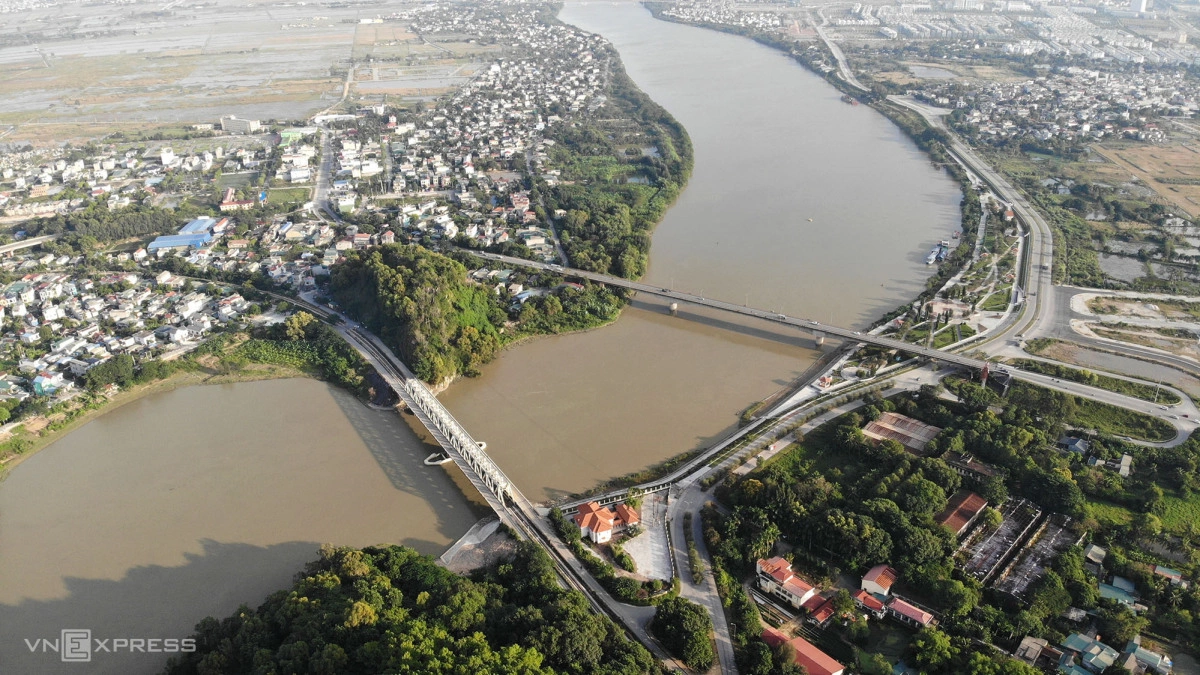
Ham Rong Bridge (L), the first to cross the Ma River in Thanh Hoa. Photo by VnExpress/Le Hoang
The north central province has two distinct seasons.
The hot season lasts from May to October, characterized by sunny weather, rainfall, and frequent storms and floods. During this period, the average temperature ranges from 38 to 40 degrees Celsius. The cold season spans from November to April, with occasional northeast monsoons. The rainfall decreases, and the season starts with a dry spell. The lowest temperature can drop as low as 2 degrees Celsius.
The ideal time to visit Thanh Hoa is from March to August. During the summer, it is perfect for visiting the local beaches, while autumn offers cool weather, making it suitable for vacations. The number of tourists also decreases during this time, resulting in more stable service prices compared to peak seasons.
Thanh Hoa offers an abundance of places to go, including scenic spots, historical sites, beaches, primeval forests, cave systems, and limestone mountains. The province is also known for hosting many festivals.
Sam Son Beach
One of the most popular tourist destinations in Thanh Hoa is Sam Son Beach, which attracts a large number of visitors during long holiday break and summer. Sam Son Beach spans 9 kilometers from Truong Le Mountain to Quang Cu Commune. The beach is divided into several parts.
Beach A is the most popular with tourists, featuring a gentle slope and strong waves. It offers picturesque spots for boat rides and cliffside photo opportunities.
Beach B has moderate waves, making it suitable for groups with elderly individuals and children. This area also offers various beachside snack bars.
Hai Tien Beach
Located approximately 15 kilometers northeast of Thanh Hoa city center, Hai Tien Beach features a lengthy shoreline, pristine sandy beaches, and an untouched landscape. Despite its unspoiled nature, Hai Tien offers modern infrastructure and convenient services. Visitors can engage in various beach activities, enjoy fresh seafood, and embark on cruises to nearby attractions such as Ne Island, Linh Truong Mountain, Lach Hoi Beach, and the Con Truong Mudflats.
Bai Dong Beach
Situated in Tinh Gia District, around 40 kilometers southeast of the city of Thanh Hoa, the capital of the eponymous province, is Bai Dong Beach, where the calm sea is suitable for swimming and other water activities. The beach features a lengthy shoreline embraced by majestic mountains, cliffs, and peaceful landscapes, setting it apart from the lively atmosphere of Sam Son and Hai Tien beaches. Bai Dong Beach is an excellent choice for overnight camping, a great activity for experiencing sunset and sunrises. Additionally, there are numerous bungalows and restaurants available at Bai Dong Beach.
Hai Hoa Beach
This beach is approximately 45 kilometers south of Thanh Hoa's capital city, near Nghe An Province border. It is a pristine beach with crystal-clear waters and soft, sandy stretches. In the early morning, visitors can observe fishermen hauling in their nets of freshly harvested seafood. Hai Hoa Beach also offers affordable culinary experiences. From the beach, one can catch sight of Hon Me Island, which is one of Thanh Hoa’s untouched natural wonderlands. However, there are not as many services available here as in other parts of Thanh Hoa.
Ben En National Park
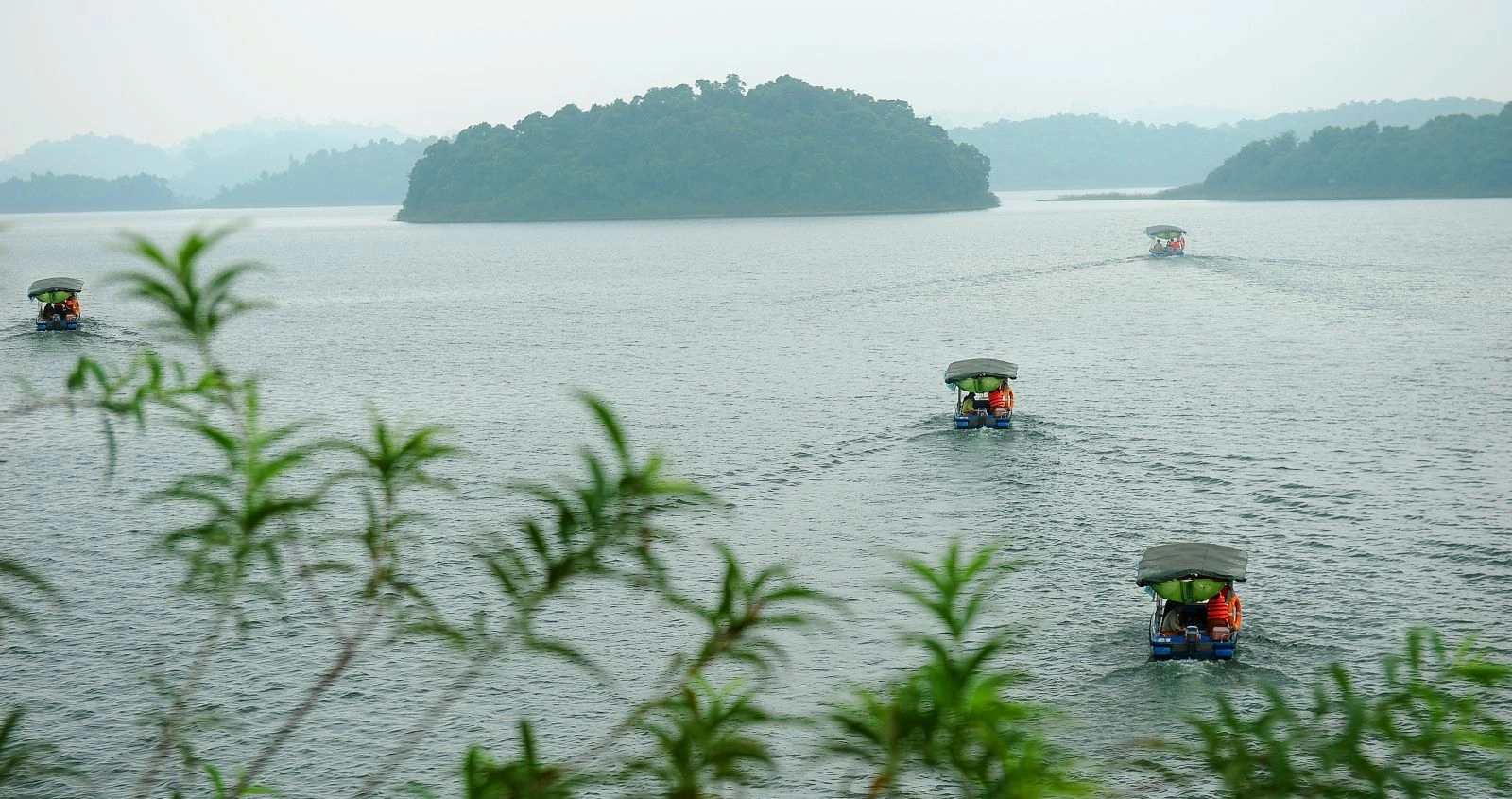
Visitors can experience natural wonders by boating through Ben En National Park. Photo by VnExpress/Nguyen A
Ben En National Park’s lakes and rivers provide an array of ways to explore, including boating, swimming, diving, picnicking on the shore, and fishing. Ngoc Cave, renowned for its limestone formations and stalactites, and the Ben En Museum, which houses antiques and historical relics, are also popular attractions here. The national park is home to a diverse ecosystem, comprising 300 valuable medicinal herbs and rare animal species like the Stump-tailed macaque (macaca arctoides, a species of Old World Monkey) and the beautiful great hornbill bird.
Pu Luong Nature Reserve
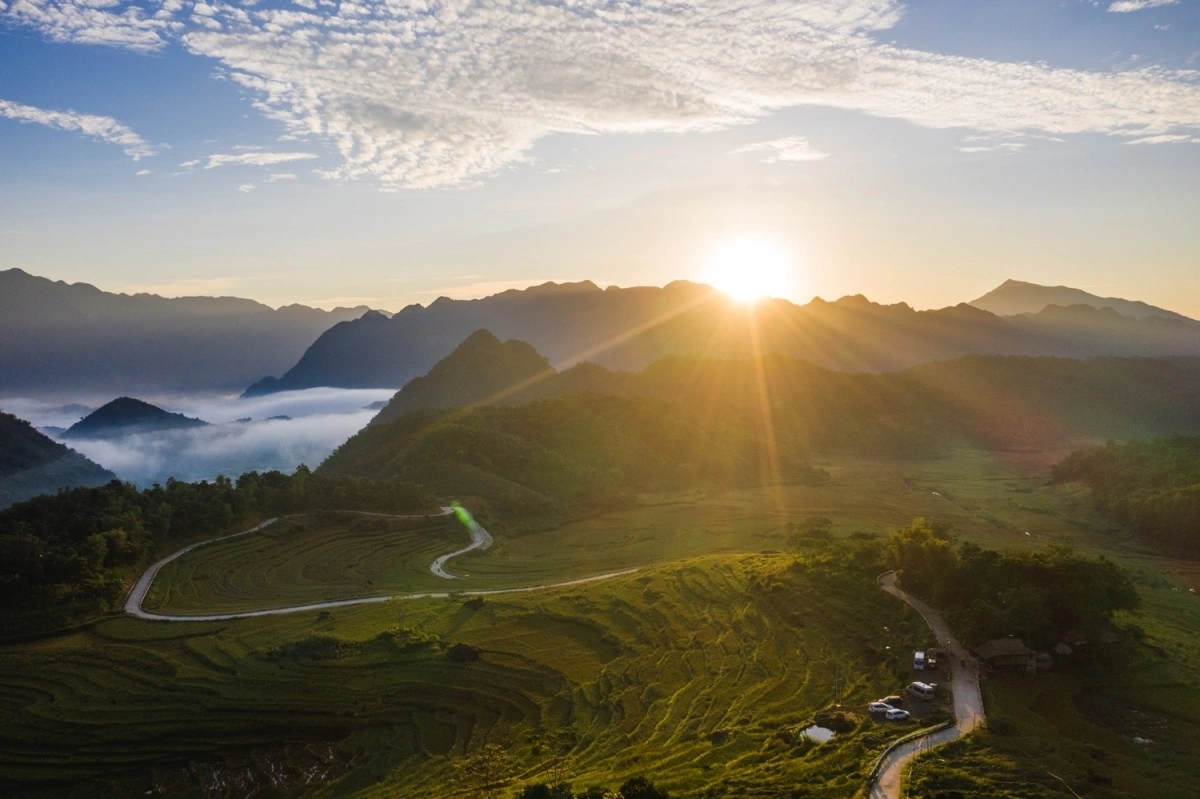
Pu Luong is magnificent in the ripe rice season. Photo by VnExpress/Tuan Dao
Spanning over 17,500 hectares, Pu Luong Nature Reserve offers a natural sanctuary situated at an altitude of 1,700 meters above sea level. With its cool climate and pristine landscapes, Pu Luong is a haven for nature enthusiasts. The reserve showcases two enchanting rice seasons in May and October, which attract numerous tourists to view the rice paddy terraces. When travelers visit Pu Luong, they have the opportunity to summit Pu Luong Peak and explore Hieu Village, a traditional village home to Hieu Stream. Within the stream, tree roots have transformed into calcified stone, creating a captivating sight.
Ham Rong Historical and Cultural Relic Site
Situated approximately 3 kilometers from the Thanh Hoa city center, the Ham Rong historical and cultural relic site encompasses an area of 560 hectares. It features scenic locations, historical sites, and significant cultural and spiritual landmarks. Additionally, the area also has mesmerizing natural landscapes adorned with mountains and caves. This is the site of the Ham Rong Bridge, which was destroyed by a laser-guided American bomb in 1972 as part of an unsuccessful bid to break the Vietnamese resistance by depriving people of life’s essential supplies.
Cam Luong Fish Stream
Located along the Ho Chi Minh Road, approximately 80 kilometers west of Thanh Hoa City, the Cam Luong Fish Stream originates from the waters of the Bo Um Limestone Mountain in the Truong Sinh mountain range. Despite its short length of around 150 meters, this stream is home to many differently colored and sized fish. Throughout the year, the spring water remains crystal clear, while during the rainy season, it can be 80 centimeters deep. The ideal time to visit Cam Luong is between April and September, when the views of fish swimming are most mesmerizing.
Ho Dynasty Citadel

Situated 45 kilometers from the center of Thanh Hoa City, the Ho Dynasty Citadel served as the old capital of Vietnam. It was constructed by Ho Quy Ly, the founding emperor of the Ho Dynasty, in 1397. Visitors can marvel at the citadel, constructed entirely from stone blocks, some weighing over two tons. Recognized by UNESCO as a world cultural heritage site in 2011, the citadel represents one of the few remaining stone ramparts in the world.
Lam Kinh Historical Site
The Lam Kinh Historical Site is an integral part of the Lam Son Cultural Space, an ancient land that dates back to the time of Hung Kings, the mythical founders of the Vietnamese nation. Lam Kinh served as the cradle of the Le Dynasty, established by King Le Loi in 1428. The site is surrounded by Dau Mountain, Chua Mountain, and Huong Mountain, while the Ngoc River flows around it. The site encompasses palaces, temples, shrines, tombs, and scenic walking paths. This is one of the most well-preserved structures of its time period. The historical information kept within has helped history lovers understand more about the Le Dynasty.
The Le Dynasty Thai Temple

The Le Dynasty Thai Temple is 2 kilometers from the city center, in Dong Ve Ward. The temple is dedicated to the worship of the 27 Le Dynasty Emperors, the Empress Mother, and other dukes, including prominent figures like poet Nguyen Trai and general Le Lai, who played crucial roles in founding the country. The Thai Temple houses numerous valuable original artifacts.
Originally constructed in Lam Kinh, Tho Xuan District, the original Thai Temple was later relocated to Thang Long (the former name of Hanoi) and renamed Hoang Duc Palace. In 1805, King Gia Long ordered its transfer to Bo Ve Village. Visitors can appreciate the beauty of the ancient architectural styles and the remarkable craftsmanship of the Le Dynasty at this site.
Nem chua (Fermented pork rolls)

Nem chua fermented pork rolls, a Thanh Hoa specialty, come in various forms, such as long rolls, square cuts, fermented pork pieces mixed with roasted rice powder, and grilled rolls. The preparation involves a mixture of minced pork skin, lean pork, pig ear, and a blend of spices, all wrapped in polyscias fruticosa leaves or guava leaves. Nem chua is typically served with chili sauce, offering a delightful combination of crispy pork skin, tangy fermented flavor, spicy garlic, and savory meat.
Shrimp rolls
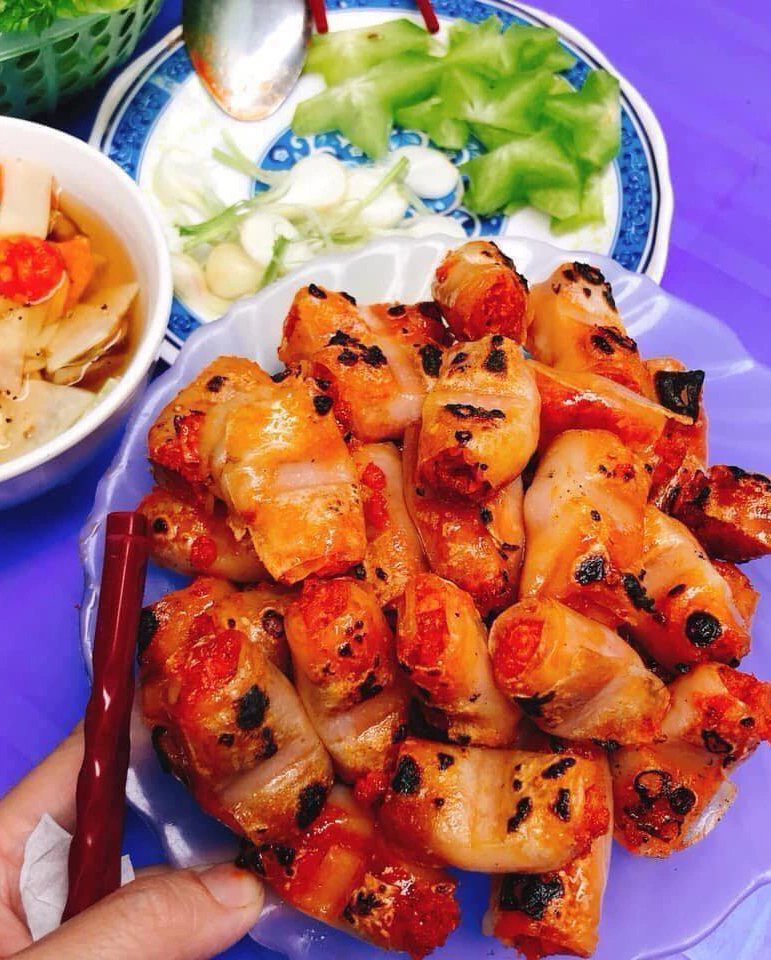
Charcoal grilling is behind the mouthwatering taste of shrimp rolls. Photo courtesy of Huong vi xu Thanh
Shrimp rolls are a humble delicacy from Thanh Hoa, featuring a filling made of crushed fresh shrimp, minced pork belly, shallots, and chopped pho (rice noodles), seasoned with spices and gac (red sweet gourd) oil for a vibrant color. The filling is then wrapped in rice paper by hand, secured with fresh bamboo sticks and grilled over charcoal. Shrimp rolls are commonly served with pickles, herbs, and a fish sauce for dipping. The sweetness of the shrimp, the mild sourness of the pickles, and the spiciness of fresh chili create a unique taste that delights diners.
Banh khoai tep (Crispy pancakes with shrimp)
These crispy pancakes are made using rice flour, chopped rau can (water dropwort), shredded cabbage, scallions, and most importantly, tep (small shrimp). The mixture is cooked in a cast-iron pan, resulting in thin, crispy pancakes. These pancakes are typically enjoyed with fish sauce and pickles made from papaya, carrots, and figs. Thanks to their crispy crust, refreshing herbs, and the savory flavor of shrimp, these pancakes are known for diners’ ability to eat a lot of them!
Banh cuon (Rice rolls)

Thanh Hoa rice rolls are often served alongside eel porridge. Photo by VnExpress/Do Trang
Distinct from banh cuon in northern provinces, Thanh Hoa rice rolls are filled with shrimp and fried shallots. Instead of using thin bamboo sticks, Thanh Hoa locals use large bamboo pipes to shape the rice rolls. One popular variation is the unfilled rice roll, cut into cylindrical shapes and garnished with fried shallots. It is typically enjoyed hot with fish sauce or alongside eel porridge, creating a unique combination. Pork rolls and chili peppers are commonly served with the rice rolls. Beer and/or rice wine can also be used to wash down this great dish.
Goi ca nhech (Pisodonophis boro salad)
Goi ca nhech features a long, smooth-skinned and robust fish commonly found in brackish water. After removing the slime, skin, and bones, the fish meat is mixed with galangal and lemongrass. It’s mixed with roasted rice powder when served.
The highlight of the dish is a dipping sauce called cheo made from crushed fish bones, pork belly, me (fermented rice), chicken eggs, and spices. It is cooked to obtain a red-orange color with a unique flavor. In Thanh Hoa, it is common for locals to wrap the fish salad in fig leaves, adding ingredients such as red onions, rice crackers, and cheo.
Banh rang bua (Rice cake filled with minced pork, onions, and wood ear mushrooms)
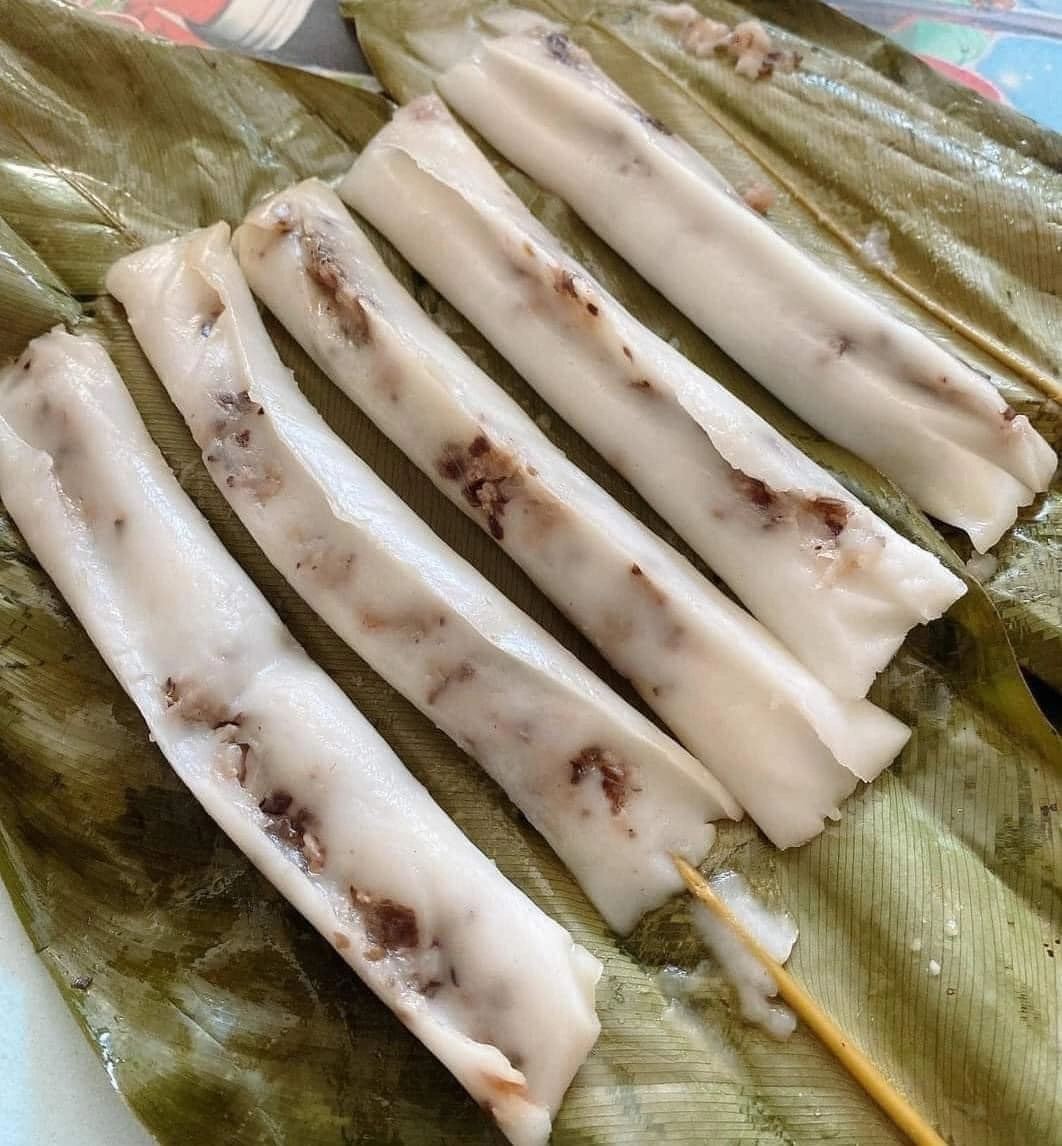
Banh rang bua unwrapped. Photo by Pham Cuc
Banh rang bua is wrapped in arrowroot or banana leaves. The dough is made from plain rice flour and the filling consists of pork shoulder, wood ear mushrooms, onions, and pepper. The cake is cooked by boiling or steaming and is served with a fish sauce mixture, complemented by lime juice, chili, or pepper.
Banh rang bua is most enjoyable when served hot. Removing the leaves reveals a green color infused into the outer layer of the cake. The aroma of onions and the combination of sweetness and richness from the filling create a delightfully flavorful experience.
Banh gai tu tru (Black glutinous cake)
This cake is made with ramie leaves, glutinous rice flour, and molasses, resulting in a characteristic black crust. The filling is made of sugar, green beans, grated coconut, and banana oil. The banana leaves used to wrap the cake are dried and aged naturally on the tree, creating a pleasant aroma. The combination of soft glutinous rice with the sweetness of mung bean paste and molasses creates a unique flavor that sets this cake apart.
There are several hotels in the city center, such as Muong Thanh Grand Hotel, Melia Vinpearl Thanh Hoa, Phu Hung Hotel, Central Hotel, and Phuong Hoang Hotel. The average room rates range from VND600,000 to over VND1 million ($25.55 to $42.59) per night.
Hotels and motels near the beaches and resorts generally have higher prices. In Sam Son Beach, visitors seeking seaside accommodations with beautiful views can consider hotels, resorts, and private villas at the FLC and Van Chai resorts. At Hai Tien Beach, there are options like the Paracel resort, Moonlight Hotel, Hai Tien resort, and Eureka Linh Truong. At Bai Dong Beach, you can check out Nghi Son Eco Island. The room rates for these locations range from VND800,000 to approximately VND4 million ($34.07 to $170.36) per night.
Alternatively, budget motels in the city center or districts are available, offering essential amenities. The price for motels in Thanh Hoa is around $300,000 ($12.78) per night.

Thanh Hoa is approximately 160 kilometers from Hanoi via National Highway 1A. It is approachable by various means of transportation, including trains, motorcycles, buses, or planes, depending on your starting location.
The ticket price for the Thong Nhat (Reunification) Train from Hanoi varies from VND140,000 to VND280,000 ($5.96 to $11.93) per ticket, depending on the seat class and train type. This option allows travelers to save money while enjoying the scenic route.
Numerous bus companies operate routes from Hanoi to Thanh Hoa. Tickets can be purchased at the My Dinh or Giap Bat bus stations, with prices ranging from VND150,000 VND to VND200,000 ($6.39 to $8.52) per ticket.
From Ho Chi Minh City, which is more than 1,400 kilometers away, the most convenient mode of transportation is by plane to Tho Xuan Airport. The round-trip ticket prices for Vietnam Airlines, Bamboo Airways, and Vietjet Air are approximately VND2 million to VND3 million ($85.18 to $127.77), with a flight duration of nearly 2 hours.
To reach the city center from the airport, visitors can take taxi, shuttle service, or bus. The three major taxi companies in Thanh Hoa are Mai Linh, Mekong, and Taxi 36. Local buses are available for transportation within Thanh Hoa.
Story by Quynh Mai, Tam Anh